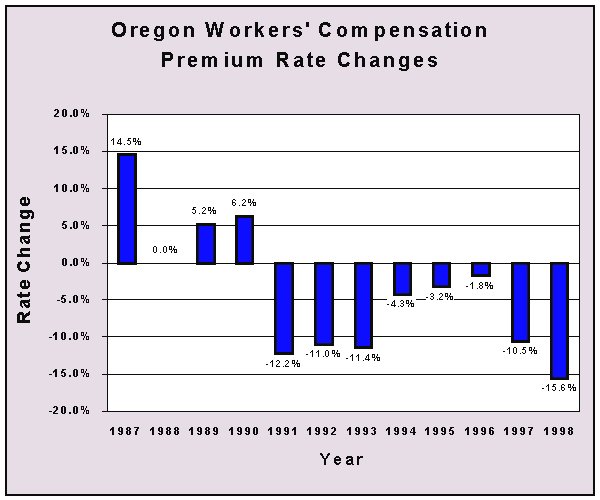
Legislative Represenative
e-mail: lisa@aoi.org
IWA Note: This page is no longer at AOI's site. It had been last updated by them on May 4,1998. Lisa Trussell is a member of MLAC as of September 2002.
Associated Oregon Industries
Oregon Public Policy Issues: Workers' Compensation
 |
Lisa Trussell Legislative Represenative e-mail: lisa@aoi.org |
Oregon State Workers' Comp. Division (WCD)
How can we continue to protect and preserve the workers’ compensation system? Stability and predictability are key elements in any successful workers’ compensation system. Oregon’s system is now at or near the national median for awards for the first time in history, while providing affordable rates to employers. The greatest challenge now is to preserve and protect the system from those special interests that can benefit change.
How can we continue to take advantage of opportunities through the use of the Management-Labor Advisory Committee (MLAC)? This statutory committee was developed as a key piece of the 1990 Mahonia Hall package, and is designed to act as a clearinghouse for proposals to modify Oregon’s system. Similar groups function in other states, most notably Wisconsin, and have a stabilizing effect on the system, by acting as a gate-keeper, thereby limiting change to those proposals upon which there is management and labor agreement. AOI staff member Lisa Trussell is a member of this committee appointed by the Governor.
What issues are currently being faced by MLAC? What has MLAC done to date? All sunset provisions have been reviewed with agreement to lift the sunset language for all but two of the provisions. Still under discussion are the provisions of exclusive remedy for denied claims and the stay of compensation pending appeal. Co-Chairs of the MLAC presented a preliminary report on MLAC's activities to a joint legislative task force Chaired by Representative Steve Harper (R-Klamath Falls) on January 27, 1998.
What process is MLAC using to perform its work? A list of items that go beyond the sunsets was developed by MLAC during discussions on the sunset issues. That list is being referred to as the "Parking Lot". These items will be addressed in a priority order throughout 1998. AOI's Workers' Compensation Policy Committee has met and discussed the issues as to their importance to the business community.
A copy of the report to Representative Harper's committee and the "Parking Lot" issues can be obtained through AOI.
MLAC Subcommittees, and Issues
How can AOI Members contribute to the process? AOI members are encouraged to participate by becoming involved in the AOI Workers’ Compensation Policy Committee where many ideas will be discussed. Further participation is encouraged in the MLAC process by attending and participating in those meetings.
Please contact Lisa Trussell to offer your assistance, share ideas, or ask questions.
Oregon's Workers' Compensation system has a long and increasingly complex history. In 1913 the Legislature formed a commission of three individuals to handle virtually all aspects of Oregon's fledgling system. Today, the Workers' Compensation Division, Workers' Compensation Board, OR-OSHA, and the Workers' Compensation Ombudsman's Office all play significant roles in what has become an enormous and costly process. Two significant reform packages passed in the 90s have brought Workers' Compensation costs under control.
Oregon's Workers' Compensation system evolved from the original State Industrial Accident Commission (SIAC), which was created by the Oregon Legislature in 1913. Originally, SIAC was comprised of three commissioners who had authority to make, enforce, and administer rules and regulations needed to ensure safety in the workplace.
An Industrial Accident Fund was created to provide compensation to injured workers or their survivors. Employers in hazardous occupations had the option of paying into the Fund and thereby be immune to lawsuits arising out of workplace injuries. Employers opting out of the Fund were subject to unlimited liability under the Employer's Liability Act. (Employers in non-hazardous industries could voluntarily elect to participate in the Fund and receive its protections.) Unlike current law, both employers and workers were required to contribute to this self-supporting fund.
From 1913 to 1965 the responsibilities of the SIAC remained relatively constant with some notable changes, including:
In a dramatic moment, Democratic Governor Neil Goldschmidt, convened the two parties for which the workers' compensation system was originally designed-- Labor and Management -- and charged them with reforming Oregon's crippled system. By eliminating all other special interests from the discussions, Goldschmidt's fourteen member Mahonia Hall team, seven named by the AFL-CIO and seven named by AOI, managed in a few short months to virtually rewrite Oregon's workers' compensation law. The product of their work, SB 1197, was passed in a one-day legislative session in May of that year.
The results of the Mahonia Hall Compromise had immediate impact on Oregon's rates and benefits. Starting in 1991, Oregon rates have fallen each year for a total of 52.4% -- reflecting how far out of balance the system had been, as well as the significance and scope of the reforms. And employee benefits, which were once ranked among the worst in the nation, are now at or above the national median.
Oregon Workers' Compensation Premium Rate Changes (by year)

The 1995 Legislature revisited the subject of Workers' Compensation through an omnibus legislative package, SB 369. The bill, which was signed into law by Governor Kitzhaber in the final days of the session, increased injury awards to their highest level in history, while addressing several court decisions, which had threatened to reverse Oregon's progressive position. That legislation is scheduled to be revisited in the 1999 legislative session due to sunset provisions.
Last Updated May 4,1998
[If you found this through a search engine, you are at www.injuredworker.org]